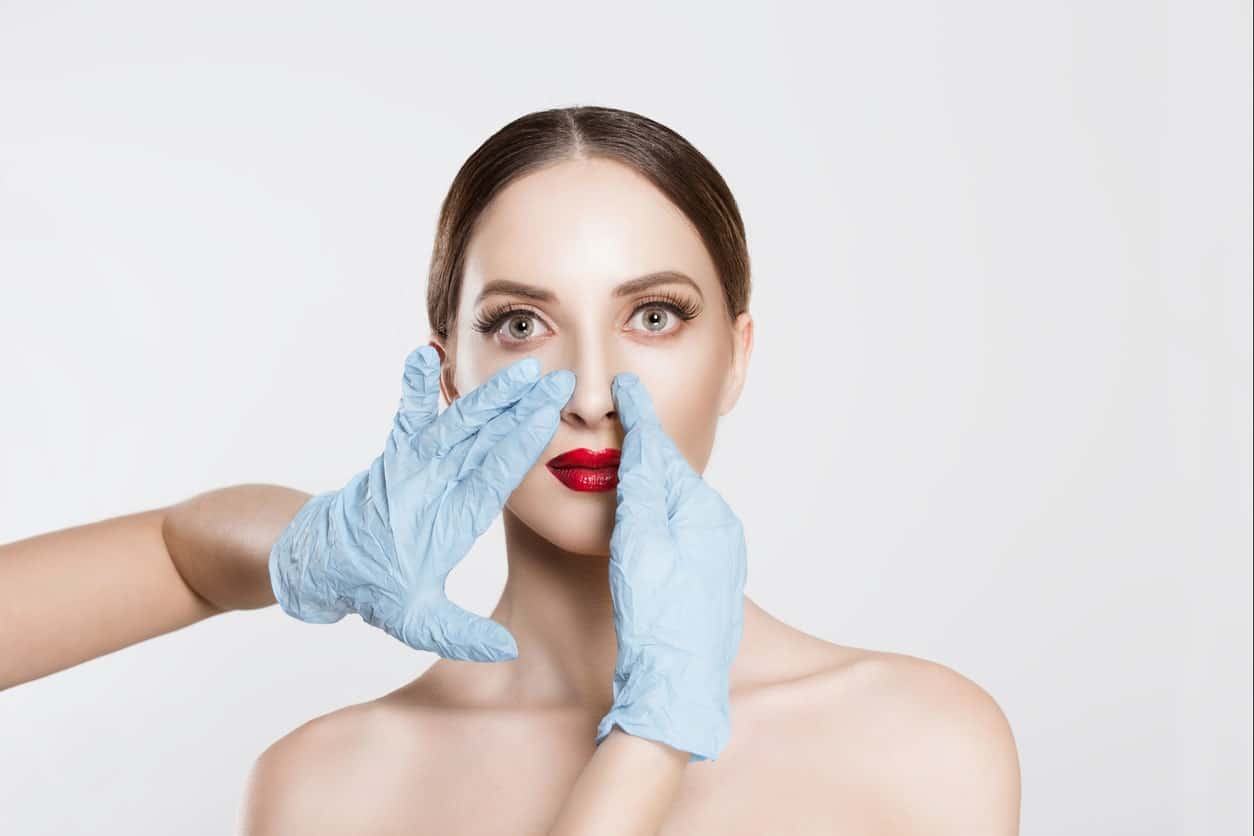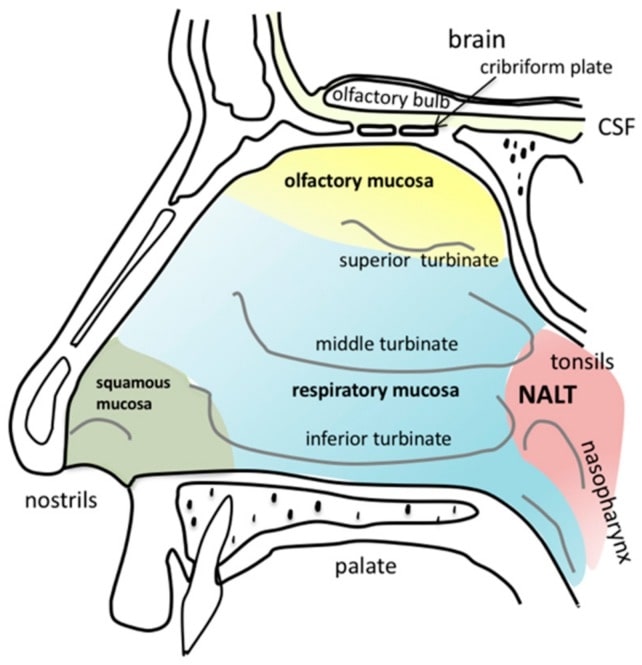What Is Hypertrophy?
Chronic nasal obstruction or a stuffy nose is often caused by enlargement (hypertrophy) of the inferior turbinate. Congested nasal obstruction can impair normal breathing, forcing patients to breathe through the mouth and often affects their daily activities.

Enlarged turbinates and nasal obstruction can also contribute to headaches and sleep disorders such as snoring and obstructive sleep apnea, as the nasal airway is the normal breathing route during sleep.
Diagnosis Of Interior Turbinate Hypertrophy
At the St. Louis Sinus Center, a diagnosis of inferior turbinate hypertrophy can usually be made on your first visit. After taking your history and performing an exam we will use an endoscope, a small telescope with a light on one end and an eyepiece at the other, to examine the inside of your nose. A MiniCAT Instant CT scan will also show inferior turbinate hypertrophy.
Treatments For Turbine Reduction
There are several medications available to treat the symptoms (mainly congestion) caused by inferior turbinate hypertrophy. These include:
- Nasal steroids sprays
- Nasal antihistamine sprays
- Oral decongestants
- Oral Steroids

These medications are designed to help reduce swelling (inflammation) and improve nasal breathing.
If medications are not enough, it may be necessary to perform a simple procedure to reduce the size of your inferior turbinates.
Turbinoplasty Procedure
Dr. Gould performs a simple in-office procedure at the St. Louis Sinus Center to resolve enlarged (hypertrophic) turbinates. Dr. Gould uses a small wand with a suction device to remove the excess tissue inside the inferior turbinate. The procedure takes only a few minutes, is virtually painless and results in a dramatic improvement in nasal airflow
It is occasionally performed by itself but is often combined with other procedures such as Balloon Sinus Dilation.

This is generally an excellent long-term, durable solution, allowing patients to get back to enjoying life!
The turbinate reduction procedure is occasionally performed by itself but is often combined with other procedures such as Balloon Sinus Dilation.
What Are The Turbinates And What Do They Do?
The turbinates are two spongy curled bones that protrude into the nasal passages. They can be found on both sides of the nasal cavity and are separated by the nasal septum. The turbinates are covered by respiratory epithelium covering a thick layer of vascular tissue. Named by their location, there are three turbinates: the inferior, middle, and superior turbinates. The inferior turbinate is the largest and most prone to swelling and blocking airflow.

The turbinates are responsible for directing the airflow inside the nasal cavity. The soft tissue covering them is responsible for humidifying, heating, and filtering inhaled air. It’s important to humidify the air to prevent damage to the olfactory receptors that are responsible for the recognition of various scents and odors. The epithelium layer is also the first line of immunological defense, triggering a quick immune response at the signs of microbial or chemical irritation.
What Causes The Turbinates To Swell?
Turbinate hypertrophy can develop in response to various environmental factors and infections. The mucous membranes covering the turbinates contain lots of blood vessels and they shrink or swell easily in response to various factors. The turbinates can swell due to allergies, chemical or physical irritants, temperature changes, or acute sinus infections. This creates congestion as the airflow through the nose becomes blocked. These are usually temporary conditions, and the turbinates return to normal size and the person’s congestion clears.

Persistent inflammation, allergic reactions, and continuing exposure to various environmental irritants may lead to chronic swelling of the turbinates. This usually occurs in the inferior turbinates and is called turbinate hypertrophy. This makes it difficult for the person to breath through his or her nose. Turbinate hypertrophy is associated with chronic sinus infections and can stem from an untreated deviated septum.
Removal of the factors causing irritation in the mucous membranes or treating the underlying allergies with nasal steroid sprays can reduce the swelling and improve breathing. But when this swelling is chronic, surgery may be required to reduce the size of the inferior turbinates.
What Will My Recovery Be Like After Turbinate Reduction Surgery?
Your recovery is individual, based on how much excess tissue Dr. Gould had to remove and whether your turbinate surgery was combined with another sinus-opening procedure such as balloon sinus dilation. You’ll get specific details during your consultations, but here are some general recovery guidelines.
These procedures don’t usually remove bone, so the recovery is not overly difficult. You’ll be stuffy for a few days to a week, but your breathing will probably be better already. Your turbinates that were reduced will swell and you will likely have some yellow or bloody crusts for a week or so. You may have some bloody discharge for the first 3-5 days, but this varies by the patient. Patients say the area is uncomfortable, but they don’t describe it as painful. You’ll take extra-strength Tylenol and that should be sufficient. You need to avoid aspirin and NSAIDs such as Motrin, Advil, and Aleve, as they can cause bleeding. You may be congested and feel as if you have a bad cold.
You’ll need to keep blood pressure to your face to a minimum to aid healing. Take it easy for the first week, and then gradually increase your activity. In two weeks you can exercise however you please. Most patients only need a few days off work after turbinate reduction surgery.
Is Turbinate Reduction Surgery Safe?
This is a safe procedure. Dr. Gould uses the most minimally invasive methods for these turbinoplasties. There can be some post-operative bleeding and bloody discharge, but this can be stemmed by the use of nasal saline mist spray every 2-3 hours. We will provide you will all the instructions on how to care for your sinuses after this procedure. This is a very successful, safe procedure.

Can You Reduce Swelling In The Turbinates Without Turbinate Reduction Surgery?
Yes, these are the first line of treatment for all of our St. Louis Sinus Center patients. These are the non-surgical treatments we use:
- Nasal or oral steroid sprays
- Nasal or oral antihistamines
- Nasal saline sprays or high volume irrigations
- Oral decongestants (not nasal decongestants, as these, can often allow relapse as soon as the medication is stopped)

Does Turbinate Reduction Surgery Cause Your Nose To Look Different?
No, Dr. Gould does not remove the underlying structural support of your nose, the bone, and cartilage. This procedure simply removes the excess soft tissue of the inferior turbinate. It does not change the shape of the patient’s nose in any way.
Read what our patients are saying!
"Dr. Gould is amazing and despite needing 2 surgeries (balloon sinuplasty), I consider this one of the best things I have ever done for myself. Every visit is pleasant and the knowledgeable mid-levels (usually Cynthia) are always great with answering questions and providing information without seeming like they are talking down to you. Even though I might not have had the perfect patient outcome, I consider my choosing to use them as my ENT physician a complete success."
Schedule A Consultation
If you’d like to learn more about Hypertrophy Treatment, please call 314-582-0888 to schedule a consultation with our experienced team at our offices in St. Louis and Festus, MO. You can change your life with nose surgery and you can take the first step by speaking with us.

